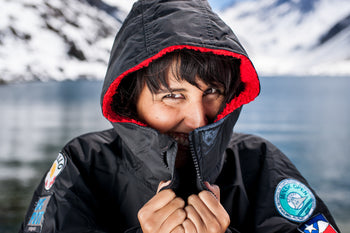6 Minuten Lesezeit
We’re excited to announce that Chilean marathon and ice swimmer Bárbara Hernández Huerta has joined Team dryrobe®!

Swimming from a very young age, Bárbara has already achieved some incredible things in the water including becoming the first Latin American swimmer to be crowned a world champion ice swimmer and being ranked number one in the world for three consecutive seasons in a row by the International Winter Swimming Association. She is also the first Chilean woman to have swam the English Channel, Catalina Channel, The Strait of Gibraltar and complete the triple crown of open water swimming!
But Bárbara has some big plans for the future, including finishing the legendary Ocean’s Seven challenge, becoming the first South American to do so, and setting a Guinness world record by swimming 2.5km in Antarctica!
Ahead of her attempt at this record-breaking swim in Antarctica, we caught up with Bárbara to talk about how she got into open water swimming, her training regime and learn more about some of the toughest challenges she’s faced...

How did you get into open water swimming?
I started swimming when I was 7 years old because I loved to swim in the sea with my Dad. I always competed in the pool and in my teens I discovered open water swimming. I was selected nationally and my dream was always to swim the main oceans and straits of the world.
I am also a psychologist and I have a master's degree. 6 years ago I learned about ice swimming and from there came the idea of practising it in our cold sea waters and glaciers in Chile.
How long have you been competing as an open water swimmer and what does it mean to you?
I have been a competitive swimmer for 29 years, almost all my life! Swimming is my place in the world, water means home and belonging. It is my very concrete way of showing that nothing is impossible, it connects me with nature in a unique way, allows me to represent my country, and also lets me discover unique places around the world whilst doing what I love.
Where was your first ice swim and what did you like about it?
My first swim on ice was in 2014 in the Perito Moreno Glacier, at an event organised by the swimmer Matías Ola with more than 100 swimmers from all over the world. Our speciality for this type of swimming is that we swim without a wetsuit, lanolin or Vaseline.
Never in my life had I seen so much snow, much less a glacier! But I felt that something was calling me. The pain of swimming in cold water wasn’t greater than my emotion of doing something that I thought was impossible and really enjoying it (and swimming well and fast!). That day I began to dream big.

How do you train for your incredible swim challenges?
My training in recent years has been increasingly rigorous. I train up to 4 hours a day swimming in a heated pool from Monday to Saturday, plus I’m in the gym 4 times a week and yoga 3 times a week. I also swim in very cold waters in the Laguna del Inca in the middle of the Andes Mountains, as well as swimming in the sea and in our amazing Chilean glaciers.
How do you feel after completing an ice swim and what keeps you motivated during swimming?
When you finish swimming on ice, the most difficult part of the swim really begins. Recovery from hypothermia is always complex, painful, and challenging. I try to focus on thoughts that give me strength - my family, my team, remembering that I do what I love. All those thoughts are what keep me motivated during the swim too.
How do you recover after a swimming challenge?
If they are long swims I need equipment to help me get out of the water and also with hypothermia. If they are shorter swims the important thing is to take off the wet swimsuit, wear comfortable clothes, drink warm drinks, and if possible use the heating of the car for recovery.
What has been your most challenging swim and why?
It's a difficult question for an extreme swimmer, I always answer that the most difficult swim is the swim to come. But also I think that swimming Lake Chungará at 4570 meters high for 7.5 km and more than 2 hours in really very cold waters was one of the most difficult things I have done. Also, completing the Molokai Channel in 15 hours and 40 minutes whilst coping with the stings from two Portuguese Jellyfish and my leg going completely asleep with a lot of pain!

How did it feel to be voted as the 2020 World Open Water Swimming Woman of the Year?
It was an amazing recognition that for me symbolises all the hard work and teamwork of the last few years. It's an example that nothing is impossible, even coming from countries like Chile where athletes don't have as much support.
Where has been your favourite place to swim in the world?
The Chilean Patagonia, with our amazing and unique glaciers, and for the kind people and delicious food.
What are your goals for 2022?
This year we are going in search of a Guinness World Record for swimming in Antarctica, then I am competing at the Ice Swimming World Championship in Russia. In May I have a qualification swim of 8 hours in water at 12°C degrees in San Francisco, then in July I’m going for my 5th ocean: the North Channel. Later on in the year, I want to swim in Chile and propose new swimming routes, return to the ice swimming circuit of the International Winter Swimming Association (IWSA) and also the International Ice Swimming Association (IISA).

Follow Bárbara
Instagram: @barbarehlla_h
Twitter: @barbarellah
#dryrobeterritory
Published on January 21, 2022
